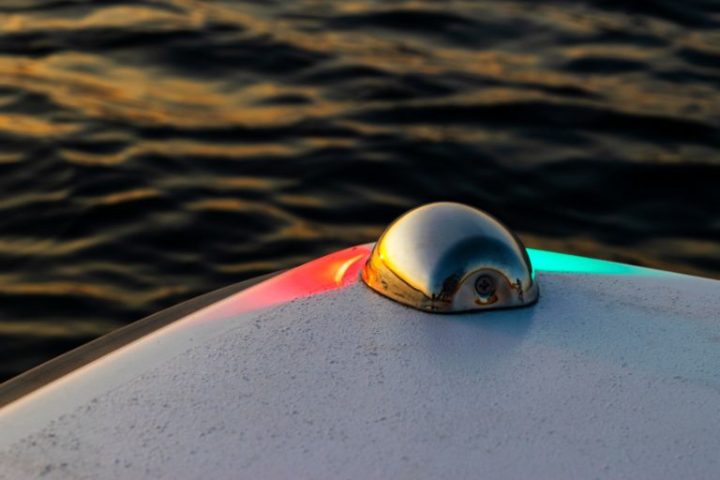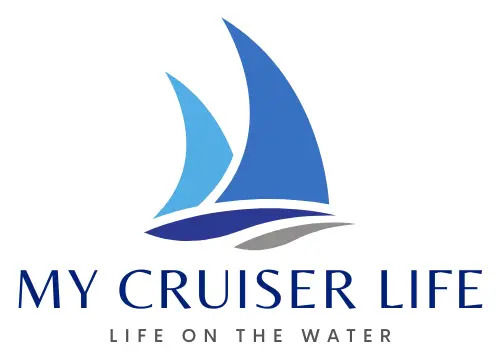What is the green light on a boat? What is the red or white light on a boat? This article will look at the perplexing world of boat lights, including what they mean and their importance.
Table of Contents
- Navigation Lights and Their Meanings
- Red Interior Lights on Boats
- The Importance of What Side is the Green Light on a Boat, the Red Light, and the White One Too!
- White, Red, and Green Light on Boat FAQs
Navigation Lights and Their Meanings
The Important Stuff – Port and Starboard
First off, we should review some sailing terms that are very important to know. Every boater should know the words port and starboard and how to use them correctly. If you have trouble remembering them, check out our article on how to remember port and starboard.
When standing at the helm for a boat, the left-hand side is the port, and the right-hand side is the starboard.
When thinking about which side of a boat has a green light or red light, thinking in terms of port and starboard makes it clear to everyone. Left and right always need clarification because they’re based on the viewer’s perspective. Port and starboard are always from the perspective of the boat to avoid confusion.

Which Side of a Boat has a Green Light at Night? What about the Red Light or the White?
So, which side has the green and which is red? And what color is a boat’s sternlight?
The green light is on the vessel’s starboard side, and the red light is on the vessel’s port side. The white light is on the stern, or back, of the vessel. But it’s a little more complicated than that.
For example, precisely how many degrees the color of light shines is standardized. So if you are putting a red and green combination light on your boat, you must ensure that it meets USCG standards and shows the correct field of view. The red and green lights are visible from dead ahead to 122.5 degrees back on each side.
Combination lights on the bow are common on smaller boats. They make both red and green lights with a single bulb and have the appropriate viewing angles. Many times this is combined with an all round white light, which serves as a masthead and stern light.
Larger vessels have two bulbs, called sidelights, that are mounted apart. They also have a masthead light, a white light shines forward. And finally, a white stern light pointed aft. A Sailing vessel under sail does not need the forward masthead light, but they need to turn it on when under power.
To understand why it’s important to think about why there are colored lights at all.
Understanding Navigation Lights on Boats
These lights are called navigation lights because the overarching purpose of them is to tell other boat skippers the direction you are headed. When you’re out at sea and you see a faint light in the distance, it’s impossible to tell if that light is stationary, moving left or right, or heading toward or away from you. Remember, you might be bouncing around in waves, and there might be other lights in the background.
For this reason, standardized lights have been used for centuries. They can trace their legal history back to the first admiralty (maritime) laws of the 19th century in the US and the United Kingdom, and they have mostly stayed the same. The modern international standards are called the COLREGs, or the “collision regulations” by the International Maritime Organization.
The laws require vessels to show different light combinations depending on the type and length of the vessel. However, basic navigation lights don’t change–all vessels have some combination of the standard red, green, and white directional lights.
But boats may have other lights. For example, ships over 50 meters long will show two white masthead lights (one fore and one aft white light shines forward), while smaller vessels only have one. Vessels towing another vessel show two masthead lights, one above the other. An anchor light is an all-around white light. There are tons of variations.
These variations are just as important as the red, green, and white lights because they show the type of vessel. Certain vessels have the right of way over others, like vessels with limited maneuverability or vessels engaged in towing, dredging, fishing, or sailing operations.
Related reading: What Is the Main Function of a Boat Trailer’s Safety Chains?
But, back to the question at hand. What do the green, red, and white navigational lights mean? If you know how the lights must be mounted, and you see a combination of those colors on a boat in the distance, you can infer the direction the vessel is pointed.
That’s vital because it lets the skipper know if another boat is a collision risk.
For example, if a skipper can see both green and red sidelights, they can say that the other vessel must be pointed right at them–head on! If they can see only a white light, then the other vessel is headed away –or could be at anchor if it appears stationary.
If the skipper sees only a green light, then the vessel must be crossing its course from left to right. In that case, our skipper has the right of way. In the COLREGs, this is called being the stand-on vessel.
Knowing how to use the colored lights safely means interpreting the lights and their meanings and also being familiar with the rules of the road and what to do in different situations.
Red Interior Lights on Boats
There is another way you might see color lights on boats, and one you might notice from movies.
Red lights, in particular, are often used in interior rooms like the bridge of a ship.
The reason red is used has to do with the human eye. Have you ever walked from a bright room into a dark one? The last time you went to the movies, perhaps?
When you first enter a dark place, your eyes take a while to adjust. In fact, the eye takes about 15 minutes. The process is called dark adaptation. Once your eyes have adjusted, though, they are thousands of times more sensitive to light than before.
The problem is that, while dark adaptation takes a while, the opposite is not true. The process can be undone immediately just by seeing a bright white light.
For this reason, red light is used inside ships at night so that the sailors can keep their night vision intact. They need their eyes fully adapted to the dark to see faint ships and obstacles on the horizon.
Therefore, keeping your night vision is a vital part of proper watchkeeping at sea.
The Importance of What Side is the Green Light on a Boat, the Red Light, and the White One Too!
As you can see, the red and green light on boat profiles is far more than a pretty holiday display–they are integral to safety at sea! So the next time you’re down by the port or out on the water, practice a little and ask yourself which way each boat is heading and, more importantly–do you have the right of way?
Every skipper should remember the light combinations, but it’s a challenge if you don’t live your life on the water every day. Even then, an occasional light combination appears that you can’t remember from the books. So a handy reference card or book at the helm is always a good idea.
- Davis 125 Navigation Rules Quick Reference Card Has the new U.S. Buoyage System, inland and international rules, right of way, lights, sound signals, new bridge signals, graphically summarized and easy to read.
Prices pulled from the Amazon Product Advertising API on:
Product prices and availability are accurate as of the date/time indicated and are subject to change. Any price and availability information displayed on [relevant Amazon Site(s), as applicable] at the time of purchase will apply to the purchase of this product.
Prices pulled from the Amazon Product Advertising API on:
Product prices and availability are accurate as of the date/time indicated and are subject to change. Any price and availability information displayed on [relevant Amazon Site(s), as applicable] at the time of purchase will apply to the purchase of this product.
White, Red, and Green Light on Boat FAQs
Is the green light on the left or right on a boat?
When standing on your own boat and looking forward, the green light is on the right side, or more appropriately, the starboard side. However, when looking at another vessel that is pointed toward you, the light will appear on its left side, still its starboard side. This is exactly why left and right are not used on boats, and port and starboard are.
Do you have to have red and green lights on a boat?
International and state laws require specific types of lights on boats of all sizes. In most places, very small boats–usually less than 16 feet–that are human or sail powered, like rowboats, kayaks, or dinghies, don’t need red and green lights. However, any boat with a motor, and any vessel larger than 16 feet, must have proper navigation lights. That includes the red and green sidelights, masthead light, and stern light.
What do the colored lights on boats mean?
The colored lights you see on each side of a boat are for navigation. When on the water at night, it is impossible to tell the direction other vessels are going. The skipper needs to know which way the other boat is headed to avoid a collision. So the red, green, and white lights are standardized, and the skipper knows what it means if they see various combinations of lights.
What do green and white lights tell you on a boat?
The green, red, and white lights on a boat are for navigation in the dark. Every boat has the same standard colors, so every other vessel can tell the direction a boat is moving from the lights they can see.




are there a green light on the side of a boat near the back side